A Study on Organizational Culture, Change, and Learning at Sanitarium
VerifiedAdded on 2021/06/17
|11
|2425
|35
Report
AI Summary
This report provides an in-depth analysis of Sanitarium, a health and wellbeing company, focusing on its organizational culture and learning mechanisms. The report begins with an introduction to Sanitarium, its history, and its product lines, including breakfast cereals and vegetarian products. It then delves into the concept of organizational culture, defining its key components and applying these concepts specifically to Sanitarium. The report highlights the company's values, norms, and expectations, which guide employee behavior and interactions. The discussion further explores Sanitarium's change strategy, examining how the company has adapted to changes in the market, consumer preferences, and lifestyles. It also discusses the introduction of new products in response to these changes. The report emphasizes the importance of organizational learning, describing how the company's leaders have fostered a culture of continuous improvement and employee development through training and performance evaluations. The report concludes with recommendations for Sanitarium, such as focusing on health products and maintaining employee empowerment. The company's adaptability, commitment to its values, and employee-centric approach are underscored as key factors in its success. This report offers a comprehensive look at how Sanitarium has managed organizational change and learning to maintain its position in the market.

Running head: A STUDY ON ORGANIZATIONAL CHANGE
A Study on Organizational Change
Name of the Student
Name of the University
Author Note
A Study on Organizational Change
Name of the Student
Name of the University
Author Note
Paraphrase This Document
Need a fresh take? Get an instant paraphrase of this document with our AI Paraphraser
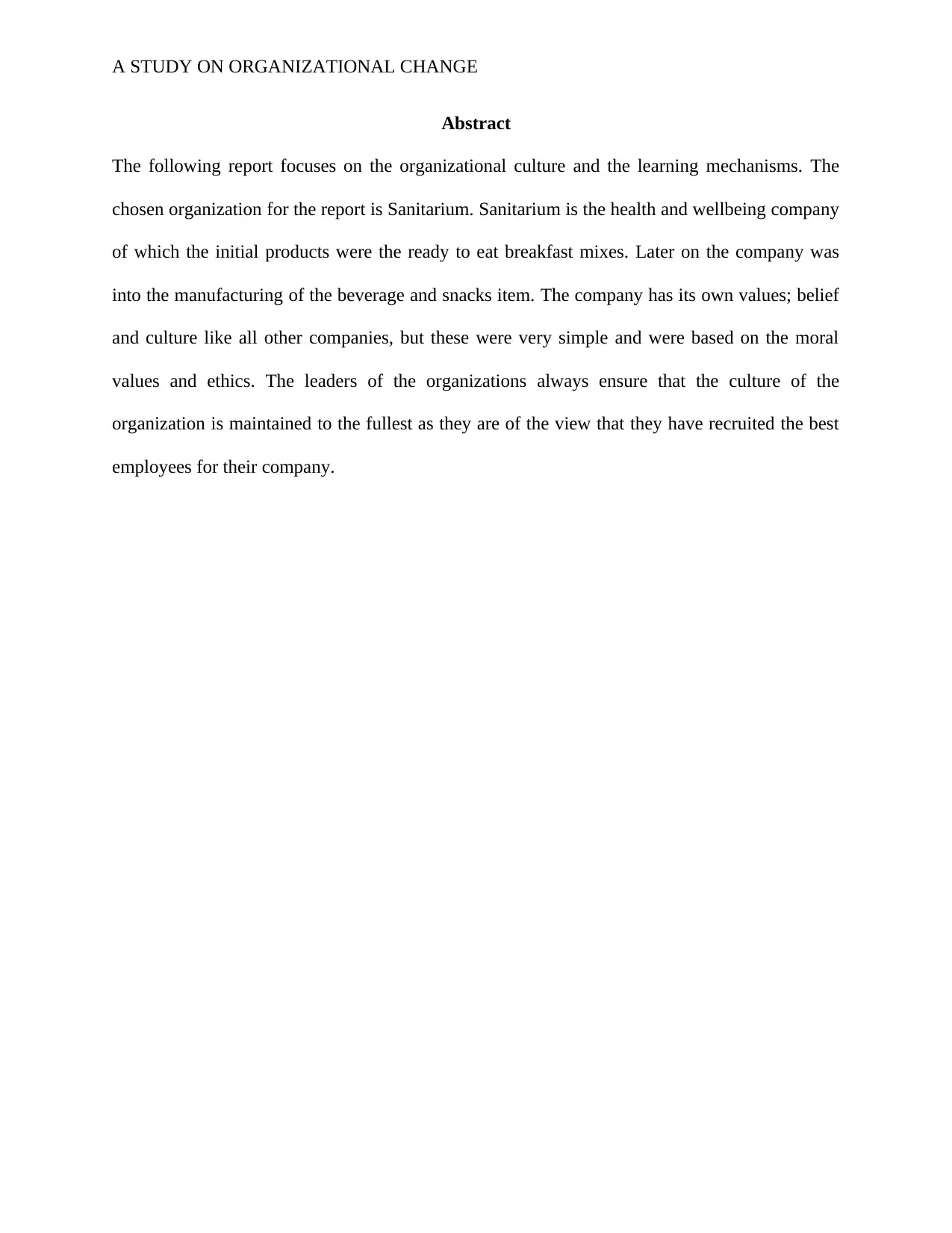
A STUDY ON ORGANIZATIONAL CHANGE
Abstract
The following report focuses on the organizational culture and the learning mechanisms. The
chosen organization for the report is Sanitarium. Sanitarium is the health and wellbeing company
of which the initial products were the ready to eat breakfast mixes. Later on the company was
into the manufacturing of the beverage and snacks item. The company has its own values; belief
and culture like all other companies, but these were very simple and were based on the moral
values and ethics. The leaders of the organizations always ensure that the culture of the
organization is maintained to the fullest as they are of the view that they have recruited the best
employees for their company.
Abstract
The following report focuses on the organizational culture and the learning mechanisms. The
chosen organization for the report is Sanitarium. Sanitarium is the health and wellbeing company
of which the initial products were the ready to eat breakfast mixes. Later on the company was
into the manufacturing of the beverage and snacks item. The company has its own values; belief
and culture like all other companies, but these were very simple and were based on the moral
values and ethics. The leaders of the organizations always ensure that the culture of the
organization is maintained to the fullest as they are of the view that they have recruited the best
employees for their company.
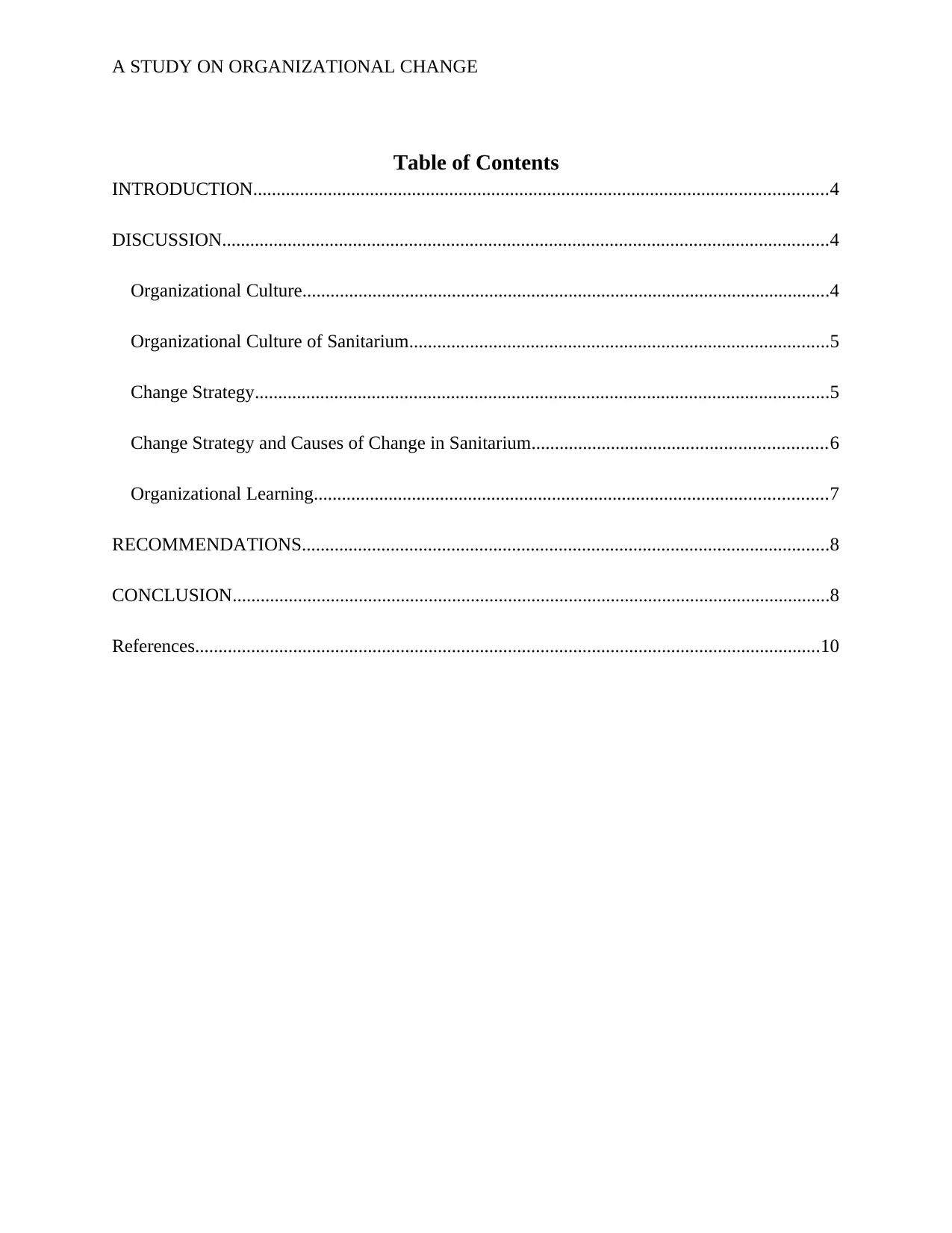
A STUDY ON ORGANIZATIONAL CHANGE
Table of Contents
INTRODUCTION...........................................................................................................................4
DISCUSSION..................................................................................................................................4
Organizational Culture.................................................................................................................4
Organizational Culture of Sanitarium..........................................................................................5
Change Strategy...........................................................................................................................5
Change Strategy and Causes of Change in Sanitarium...............................................................6
Organizational Learning..............................................................................................................7
RECOMMENDATIONS.................................................................................................................8
CONCLUSION................................................................................................................................8
References......................................................................................................................................10
Table of Contents
INTRODUCTION...........................................................................................................................4
DISCUSSION..................................................................................................................................4
Organizational Culture.................................................................................................................4
Organizational Culture of Sanitarium..........................................................................................5
Change Strategy...........................................................................................................................5
Change Strategy and Causes of Change in Sanitarium...............................................................6
Organizational Learning..............................................................................................................7
RECOMMENDATIONS.................................................................................................................8
CONCLUSION................................................................................................................................8
References......................................................................................................................................10
⊘ This is a preview!⊘
Do you want full access?
Subscribe today to unlock all pages.

Trusted by 1+ million students worldwide
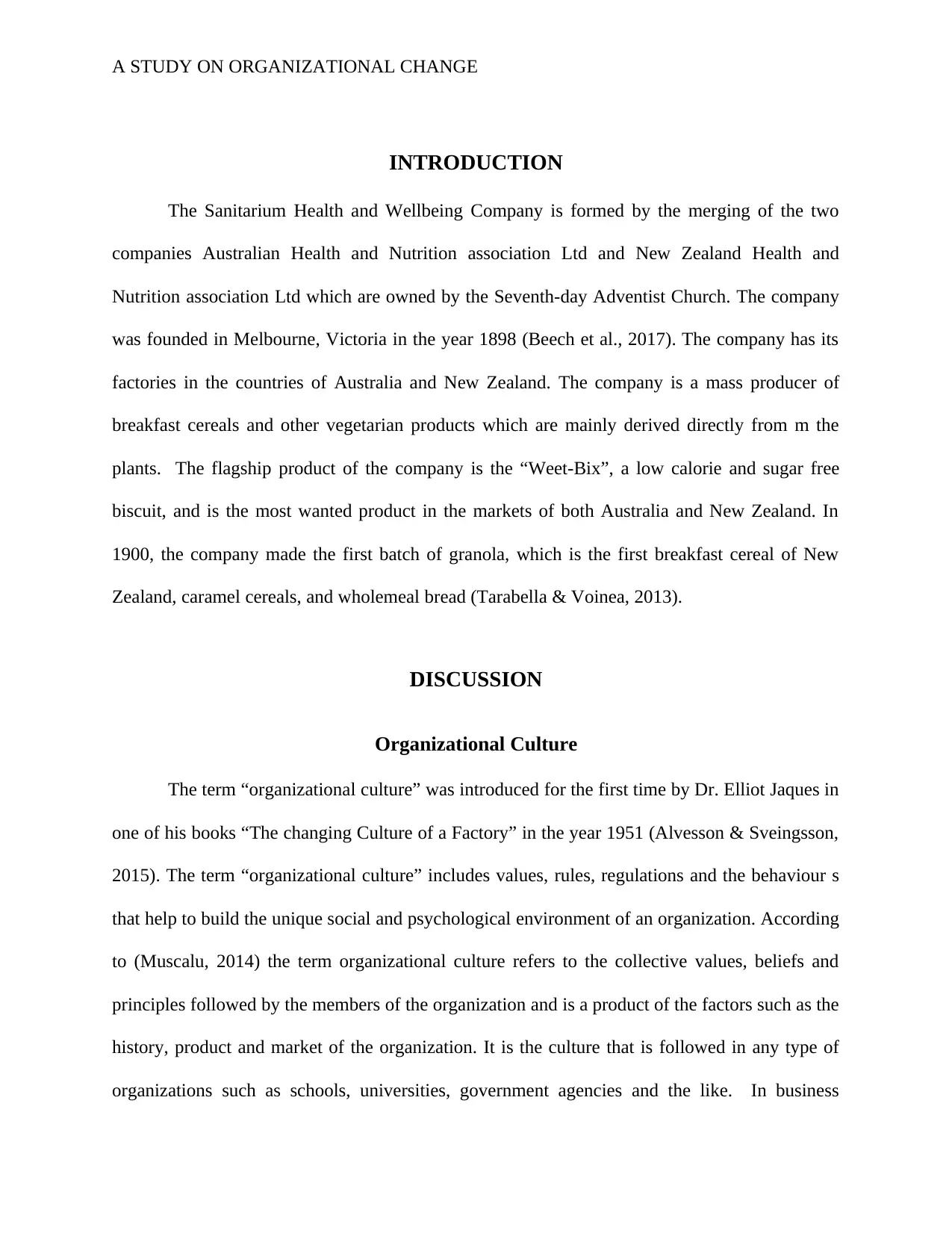
A STUDY ON ORGANIZATIONAL CHANGE
INTRODUCTION
The Sanitarium Health and Wellbeing Company is formed by the merging of the two
companies Australian Health and Nutrition association Ltd and New Zealand Health and
Nutrition association Ltd which are owned by the Seventh-day Adventist Church. The company
was founded in Melbourne, Victoria in the year 1898 (Beech et al., 2017). The company has its
factories in the countries of Australia and New Zealand. The company is a mass producer of
breakfast cereals and other vegetarian products which are mainly derived directly from m the
plants. The flagship product of the company is the “Weet-Bix”, a low calorie and sugar free
biscuit, and is the most wanted product in the markets of both Australia and New Zealand. In
1900, the company made the first batch of granola, which is the first breakfast cereal of New
Zealand, caramel cereals, and wholemeal bread (Tarabella & Voinea, 2013).
DISCUSSION
Organizational Culture
The term “organizational culture” was introduced for the first time by Dr. Elliot Jaques in
one of his books “The changing Culture of a Factory” in the year 1951 (Alvesson & Sveingsson,
2015). The term “organizational culture” includes values, rules, regulations and the behaviour s
that help to build the unique social and psychological environment of an organization. According
to (Muscalu, 2014) the term organizational culture refers to the collective values, beliefs and
principles followed by the members of the organization and is a product of the factors such as the
history, product and market of the organization. It is the culture that is followed in any type of
organizations such as schools, universities, government agencies and the like. In business
INTRODUCTION
The Sanitarium Health and Wellbeing Company is formed by the merging of the two
companies Australian Health and Nutrition association Ltd and New Zealand Health and
Nutrition association Ltd which are owned by the Seventh-day Adventist Church. The company
was founded in Melbourne, Victoria in the year 1898 (Beech et al., 2017). The company has its
factories in the countries of Australia and New Zealand. The company is a mass producer of
breakfast cereals and other vegetarian products which are mainly derived directly from m the
plants. The flagship product of the company is the “Weet-Bix”, a low calorie and sugar free
biscuit, and is the most wanted product in the markets of both Australia and New Zealand. In
1900, the company made the first batch of granola, which is the first breakfast cereal of New
Zealand, caramel cereals, and wholemeal bread (Tarabella & Voinea, 2013).
DISCUSSION
Organizational Culture
The term “organizational culture” was introduced for the first time by Dr. Elliot Jaques in
one of his books “The changing Culture of a Factory” in the year 1951 (Alvesson & Sveingsson,
2015). The term “organizational culture” includes values, rules, regulations and the behaviour s
that help to build the unique social and psychological environment of an organization. According
to (Muscalu, 2014) the term organizational culture refers to the collective values, beliefs and
principles followed by the members of the organization and is a product of the factors such as the
history, product and market of the organization. It is the culture that is followed in any type of
organizations such as schools, universities, government agencies and the like. In business
Paraphrase This Document
Need a fresh take? Get an instant paraphrase of this document with our AI Paraphraser
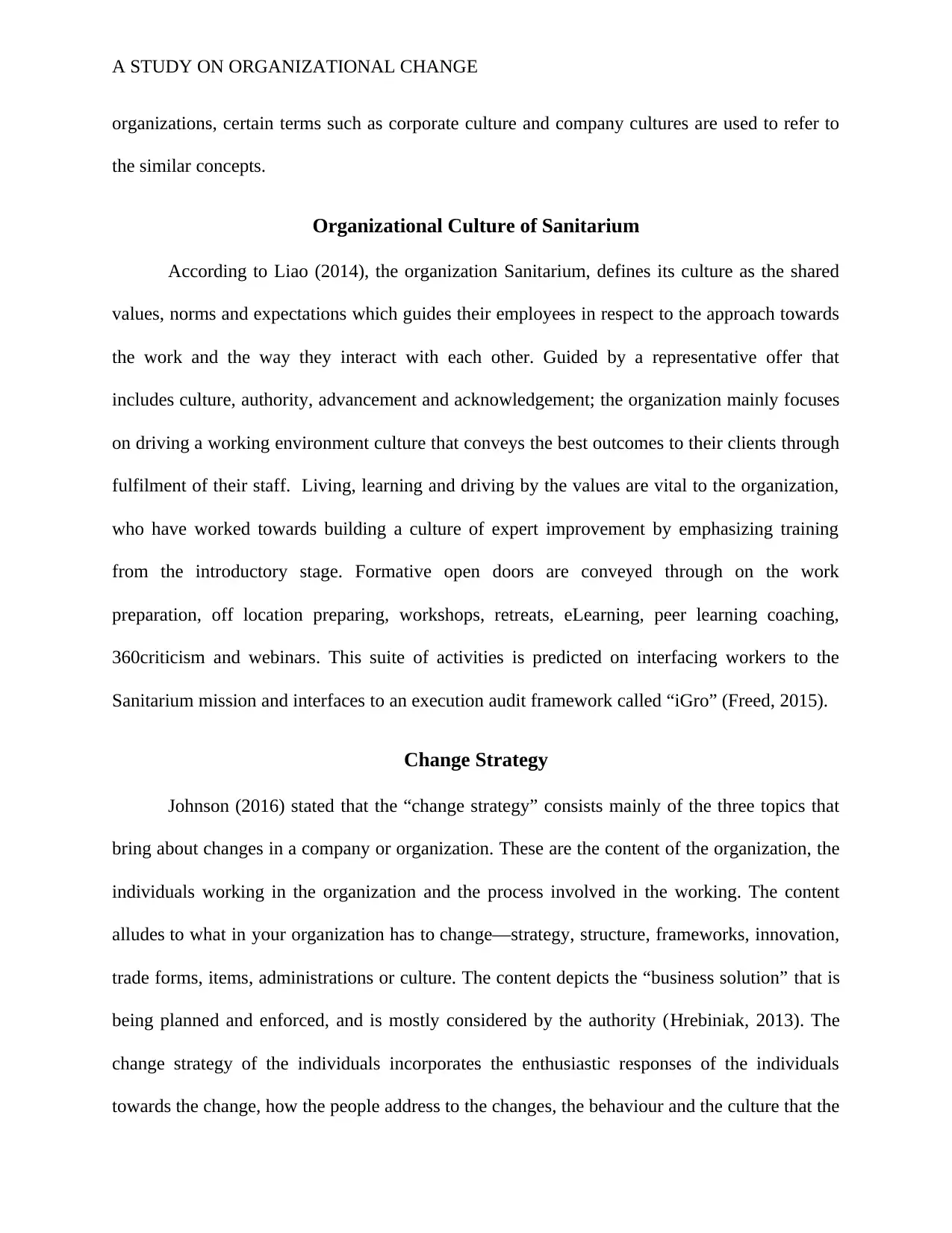
A STUDY ON ORGANIZATIONAL CHANGE
organizations, certain terms such as corporate culture and company cultures are used to refer to
the similar concepts.
Organizational Culture of Sanitarium
According to Liao (2014), the organization Sanitarium, defines its culture as the shared
values, norms and expectations which guides their employees in respect to the approach towards
the work and the way they interact with each other. Guided by a representative offer that
includes culture, authority, advancement and acknowledgement; the organization mainly focuses
on driving a working environment culture that conveys the best outcomes to their clients through
fulfilment of their staff. Living, learning and driving by the values are vital to the organization,
who have worked towards building a culture of expert improvement by emphasizing training
from the introductory stage. Formative open doors are conveyed through on the work
preparation, off location preparing, workshops, retreats, eLearning, peer learning coaching,
360criticism and webinars. This suite of activities is predicted on interfacing workers to the
Sanitarium mission and interfaces to an execution audit framework called “iGro” (Freed, 2015).
Change Strategy
Johnson (2016) stated that the “change strategy” consists mainly of the three topics that
bring about changes in a company or organization. These are the content of the organization, the
individuals working in the organization and the process involved in the working. The content
alludes to what in your organization has to change—strategy, structure, frameworks, innovation,
trade forms, items, administrations or culture. The content depicts the “business solution” that is
being planned and enforced, and is mostly considered by the authority (Hrebiniak, 2013). The
change strategy of the individuals incorporates the enthusiastic responses of the individuals
towards the change, how the people address to the changes, the behaviour and the culture that the
organizations, certain terms such as corporate culture and company cultures are used to refer to
the similar concepts.
Organizational Culture of Sanitarium
According to Liao (2014), the organization Sanitarium, defines its culture as the shared
values, norms and expectations which guides their employees in respect to the approach towards
the work and the way they interact with each other. Guided by a representative offer that
includes culture, authority, advancement and acknowledgement; the organization mainly focuses
on driving a working environment culture that conveys the best outcomes to their clients through
fulfilment of their staff. Living, learning and driving by the values are vital to the organization,
who have worked towards building a culture of expert improvement by emphasizing training
from the introductory stage. Formative open doors are conveyed through on the work
preparation, off location preparing, workshops, retreats, eLearning, peer learning coaching,
360criticism and webinars. This suite of activities is predicted on interfacing workers to the
Sanitarium mission and interfaces to an execution audit framework called “iGro” (Freed, 2015).
Change Strategy
Johnson (2016) stated that the “change strategy” consists mainly of the three topics that
bring about changes in a company or organization. These are the content of the organization, the
individuals working in the organization and the process involved in the working. The content
alludes to what in your organization has to change—strategy, structure, frameworks, innovation,
trade forms, items, administrations or culture. The content depicts the “business solution” that is
being planned and enforced, and is mostly considered by the authority (Hrebiniak, 2013). The
change strategy of the individuals incorporates the enthusiastic responses of the individuals
towards the change, how the people address to the changes, the behaviour and the culture that the
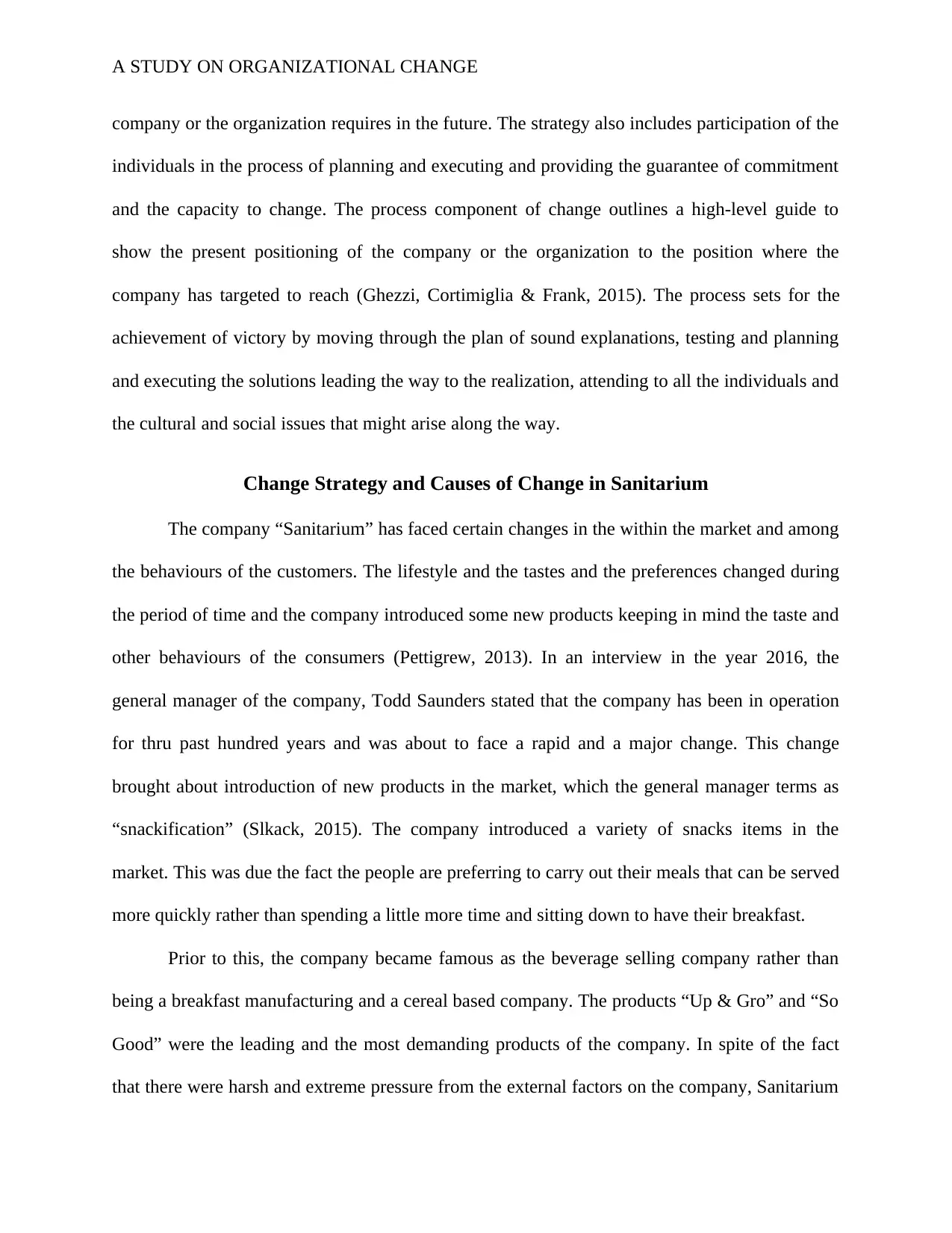
A STUDY ON ORGANIZATIONAL CHANGE
company or the organization requires in the future. The strategy also includes participation of the
individuals in the process of planning and executing and providing the guarantee of commitment
and the capacity to change. The process component of change outlines a high-level guide to
show the present positioning of the company or the organization to the position where the
company has targeted to reach (Ghezzi, Cortimiglia & Frank, 2015). The process sets for the
achievement of victory by moving through the plan of sound explanations, testing and planning
and executing the solutions leading the way to the realization, attending to all the individuals and
the cultural and social issues that might arise along the way.
Change Strategy and Causes of Change in Sanitarium
The company “Sanitarium” has faced certain changes in the within the market and among
the behaviours of the customers. The lifestyle and the tastes and the preferences changed during
the period of time and the company introduced some new products keeping in mind the taste and
other behaviours of the consumers (Pettigrew, 2013). In an interview in the year 2016, the
general manager of the company, Todd Saunders stated that the company has been in operation
for thru past hundred years and was about to face a rapid and a major change. This change
brought about introduction of new products in the market, which the general manager terms as
“snackification” (Slkack, 2015). The company introduced a variety of snacks items in the
market. This was due the fact the people are preferring to carry out their meals that can be served
more quickly rather than spending a little more time and sitting down to have their breakfast.
Prior to this, the company became famous as the beverage selling company rather than
being a breakfast manufacturing and a cereal based company. The products “Up & Gro” and “So
Good” were the leading and the most demanding products of the company. In spite of the fact
that there were harsh and extreme pressure from the external factors on the company, Sanitarium
company or the organization requires in the future. The strategy also includes participation of the
individuals in the process of planning and executing and providing the guarantee of commitment
and the capacity to change. The process component of change outlines a high-level guide to
show the present positioning of the company or the organization to the position where the
company has targeted to reach (Ghezzi, Cortimiglia & Frank, 2015). The process sets for the
achievement of victory by moving through the plan of sound explanations, testing and planning
and executing the solutions leading the way to the realization, attending to all the individuals and
the cultural and social issues that might arise along the way.
Change Strategy and Causes of Change in Sanitarium
The company “Sanitarium” has faced certain changes in the within the market and among
the behaviours of the customers. The lifestyle and the tastes and the preferences changed during
the period of time and the company introduced some new products keeping in mind the taste and
other behaviours of the consumers (Pettigrew, 2013). In an interview in the year 2016, the
general manager of the company, Todd Saunders stated that the company has been in operation
for thru past hundred years and was about to face a rapid and a major change. This change
brought about introduction of new products in the market, which the general manager terms as
“snackification” (Slkack, 2015). The company introduced a variety of snacks items in the
market. This was due the fact the people are preferring to carry out their meals that can be served
more quickly rather than spending a little more time and sitting down to have their breakfast.
Prior to this, the company became famous as the beverage selling company rather than
being a breakfast manufacturing and a cereal based company. The products “Up & Gro” and “So
Good” were the leading and the most demanding products of the company. In spite of the fact
that there were harsh and extreme pressure from the external factors on the company, Sanitarium
⊘ This is a preview!⊘
Do you want full access?
Subscribe today to unlock all pages.

Trusted by 1+ million students worldwide
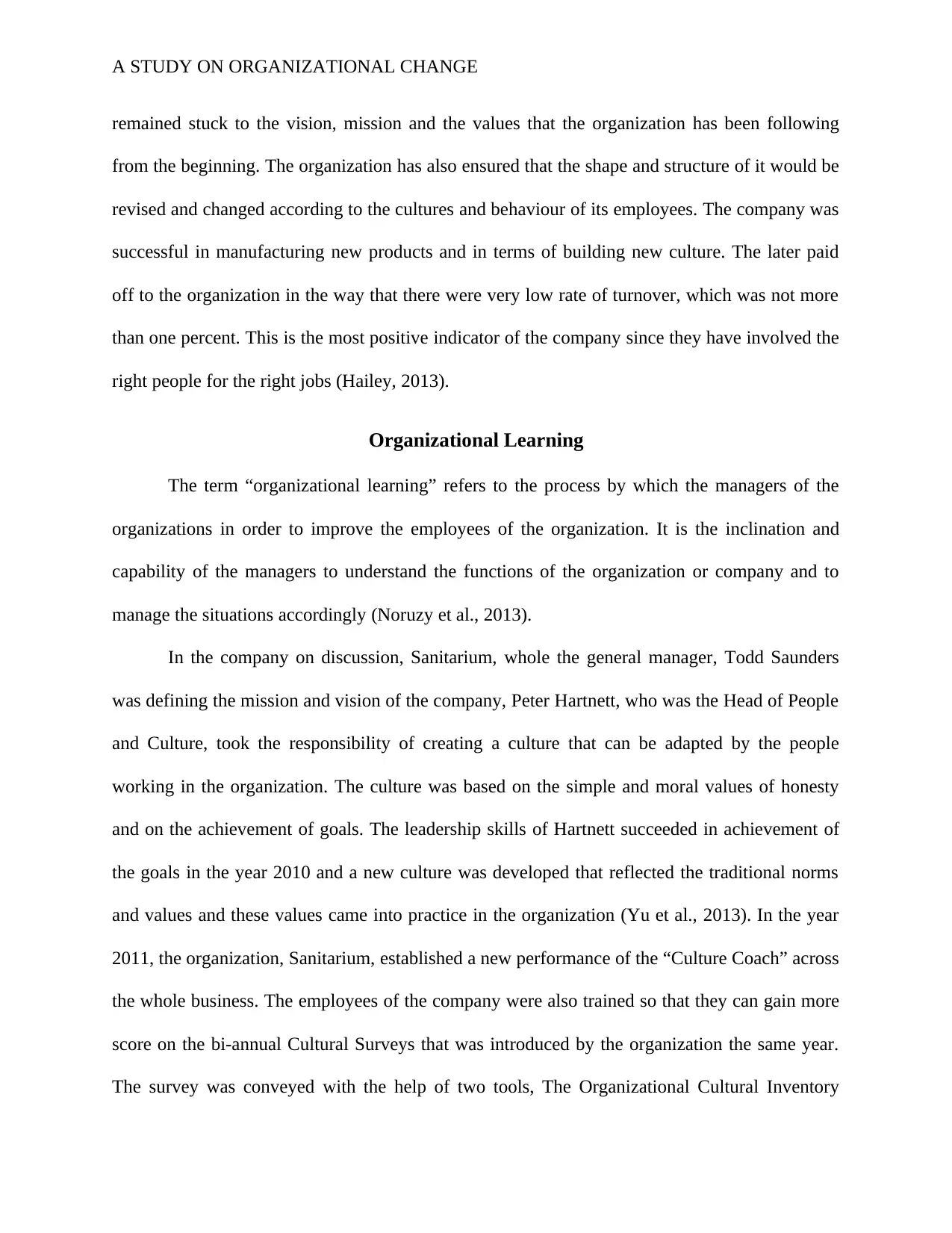
A STUDY ON ORGANIZATIONAL CHANGE
remained stuck to the vision, mission and the values that the organization has been following
from the beginning. The organization has also ensured that the shape and structure of it would be
revised and changed according to the cultures and behaviour of its employees. The company was
successful in manufacturing new products and in terms of building new culture. The later paid
off to the organization in the way that there were very low rate of turnover, which was not more
than one percent. This is the most positive indicator of the company since they have involved the
right people for the right jobs (Hailey, 2013).
Organizational Learning
The term “organizational learning” refers to the process by which the managers of the
organizations in order to improve the employees of the organization. It is the inclination and
capability of the managers to understand the functions of the organization or company and to
manage the situations accordingly (Noruzy et al., 2013).
In the company on discussion, Sanitarium, whole the general manager, Todd Saunders
was defining the mission and vision of the company, Peter Hartnett, who was the Head of People
and Culture, took the responsibility of creating a culture that can be adapted by the people
working in the organization. The culture was based on the simple and moral values of honesty
and on the achievement of goals. The leadership skills of Hartnett succeeded in achievement of
the goals in the year 2010 and a new culture was developed that reflected the traditional norms
and values and these values came into practice in the organization (Yu et al., 2013). In the year
2011, the organization, Sanitarium, established a new performance of the “Culture Coach” across
the whole business. The employees of the company were also trained so that they can gain more
score on the bi-annual Cultural Surveys that was introduced by the organization the same year.
The survey was conveyed with the help of two tools, The Organizational Cultural Inventory
remained stuck to the vision, mission and the values that the organization has been following
from the beginning. The organization has also ensured that the shape and structure of it would be
revised and changed according to the cultures and behaviour of its employees. The company was
successful in manufacturing new products and in terms of building new culture. The later paid
off to the organization in the way that there were very low rate of turnover, which was not more
than one percent. This is the most positive indicator of the company since they have involved the
right people for the right jobs (Hailey, 2013).
Organizational Learning
The term “organizational learning” refers to the process by which the managers of the
organizations in order to improve the employees of the organization. It is the inclination and
capability of the managers to understand the functions of the organization or company and to
manage the situations accordingly (Noruzy et al., 2013).
In the company on discussion, Sanitarium, whole the general manager, Todd Saunders
was defining the mission and vision of the company, Peter Hartnett, who was the Head of People
and Culture, took the responsibility of creating a culture that can be adapted by the people
working in the organization. The culture was based on the simple and moral values of honesty
and on the achievement of goals. The leadership skills of Hartnett succeeded in achievement of
the goals in the year 2010 and a new culture was developed that reflected the traditional norms
and values and these values came into practice in the organization (Yu et al., 2013). In the year
2011, the organization, Sanitarium, established a new performance of the “Culture Coach” across
the whole business. The employees of the company were also trained so that they can gain more
score on the bi-annual Cultural Surveys that was introduced by the organization the same year.
The survey was conveyed with the help of two tools, The Organizational Cultural Inventory
Paraphrase This Document
Need a fresh take? Get an instant paraphrase of this document with our AI Paraphraser
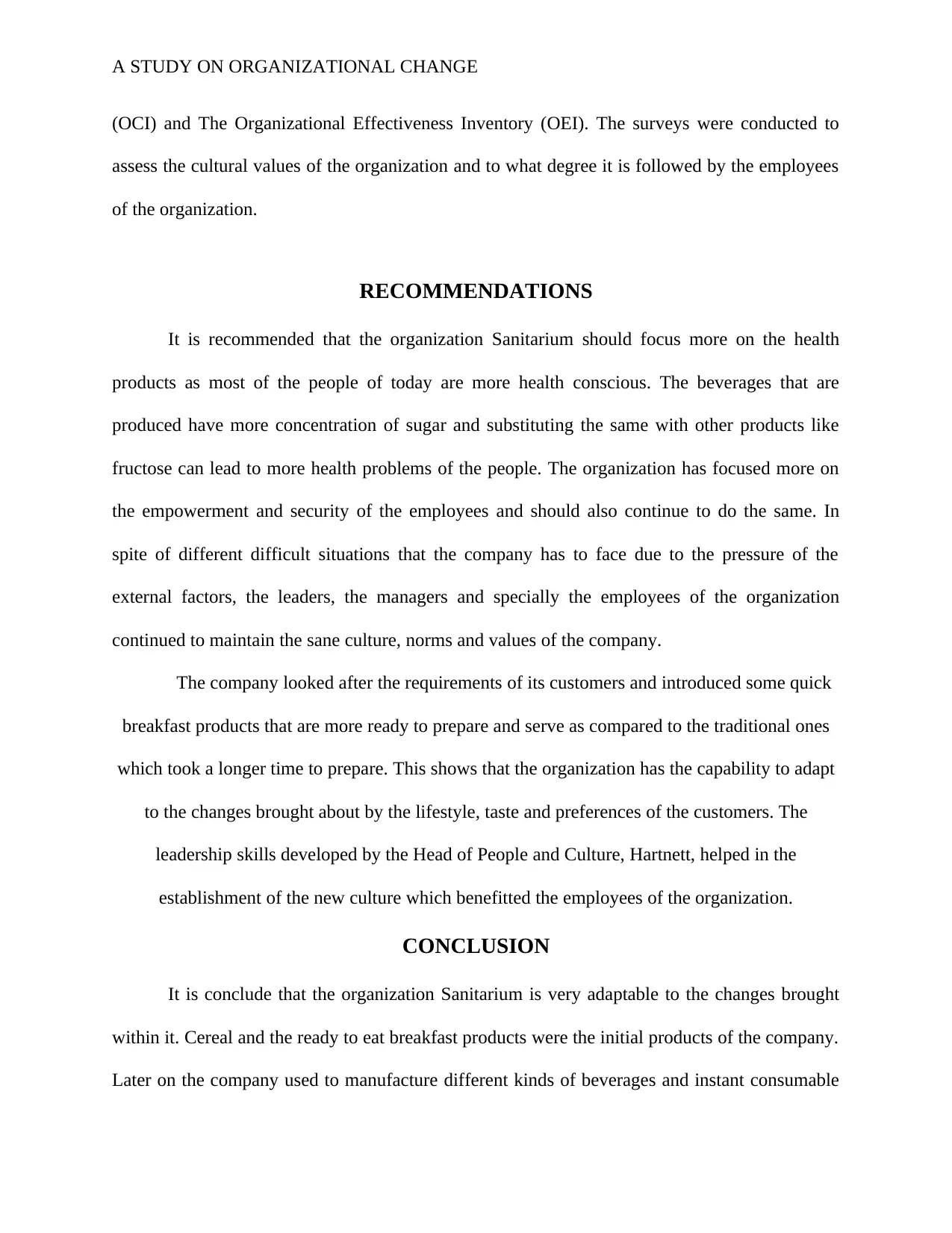
A STUDY ON ORGANIZATIONAL CHANGE
(OCI) and The Organizational Effectiveness Inventory (OEI). The surveys were conducted to
assess the cultural values of the organization and to what degree it is followed by the employees
of the organization.
RECOMMENDATIONS
It is recommended that the organization Sanitarium should focus more on the health
products as most of the people of today are more health conscious. The beverages that are
produced have more concentration of sugar and substituting the same with other products like
fructose can lead to more health problems of the people. The organization has focused more on
the empowerment and security of the employees and should also continue to do the same. In
spite of different difficult situations that the company has to face due to the pressure of the
external factors, the leaders, the managers and specially the employees of the organization
continued to maintain the sane culture, norms and values of the company.
The company looked after the requirements of its customers and introduced some quick
breakfast products that are more ready to prepare and serve as compared to the traditional ones
which took a longer time to prepare. This shows that the organization has the capability to adapt
to the changes brought about by the lifestyle, taste and preferences of the customers. The
leadership skills developed by the Head of People and Culture, Hartnett, helped in the
establishment of the new culture which benefitted the employees of the organization.
CONCLUSION
It is conclude that the organization Sanitarium is very adaptable to the changes brought
within it. Cereal and the ready to eat breakfast products were the initial products of the company.
Later on the company used to manufacture different kinds of beverages and instant consumable
(OCI) and The Organizational Effectiveness Inventory (OEI). The surveys were conducted to
assess the cultural values of the organization and to what degree it is followed by the employees
of the organization.
RECOMMENDATIONS
It is recommended that the organization Sanitarium should focus more on the health
products as most of the people of today are more health conscious. The beverages that are
produced have more concentration of sugar and substituting the same with other products like
fructose can lead to more health problems of the people. The organization has focused more on
the empowerment and security of the employees and should also continue to do the same. In
spite of different difficult situations that the company has to face due to the pressure of the
external factors, the leaders, the managers and specially the employees of the organization
continued to maintain the sane culture, norms and values of the company.
The company looked after the requirements of its customers and introduced some quick
breakfast products that are more ready to prepare and serve as compared to the traditional ones
which took a longer time to prepare. This shows that the organization has the capability to adapt
to the changes brought about by the lifestyle, taste and preferences of the customers. The
leadership skills developed by the Head of People and Culture, Hartnett, helped in the
establishment of the new culture which benefitted the employees of the organization.
CONCLUSION
It is conclude that the organization Sanitarium is very adaptable to the changes brought
within it. Cereal and the ready to eat breakfast products were the initial products of the company.
Later on the company used to manufacture different kinds of beverages and instant consumable

A STUDY ON ORGANIZATIONAL CHANGE
products such as snacks. The company maintained the traditional norms, and culture which was
based on the most simple and moral laws of honesty and achievement of the desired goals. The
culture of the organization led to the turnover to only one percent. The company on this regard
stated that they had recruited the right people for the right jobs.
products such as snacks. The company maintained the traditional norms, and culture which was
based on the most simple and moral laws of honesty and achievement of the desired goals. The
culture of the organization led to the turnover to only one percent. The company on this regard
stated that they had recruited the right people for the right jobs.
⊘ This is a preview!⊘
Do you want full access?
Subscribe today to unlock all pages.

Trusted by 1+ million students worldwide
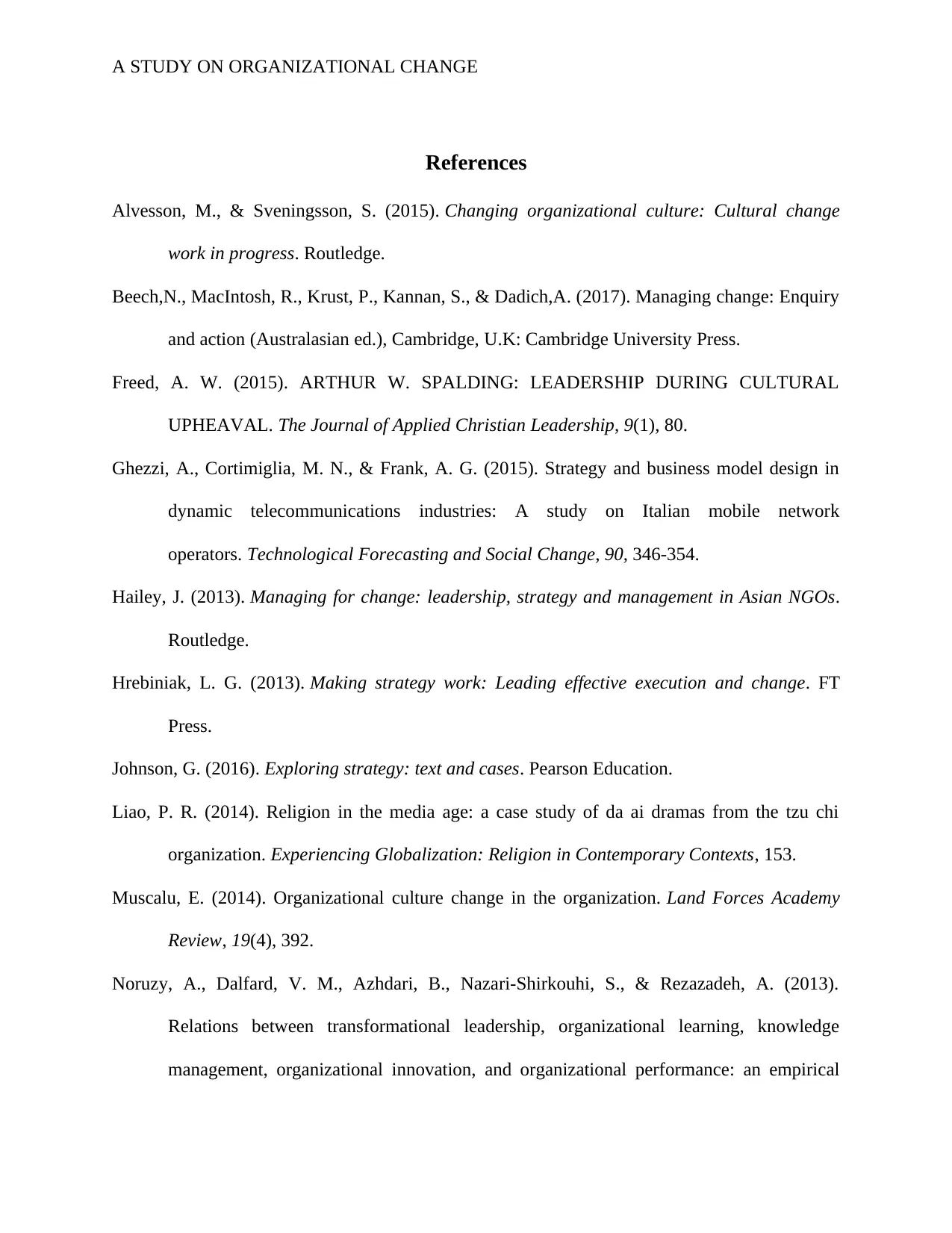
A STUDY ON ORGANIZATIONAL CHANGE
References
Alvesson, M., & Sveningsson, S. (2015). Changing organizational culture: Cultural change
work in progress. Routledge.
Beech,N., MacIntosh, R., Krust, P., Kannan, S., & Dadich,A. (2017). Managing change: Enquiry
and action (Australasian ed.), Cambridge, U.K: Cambridge University Press.
Freed, A. W. (2015). ARTHUR W. SPALDING: LEADERSHIP DURING CULTURAL
UPHEAVAL. The Journal of Applied Christian Leadership, 9(1), 80.
Ghezzi, A., Cortimiglia, M. N., & Frank, A. G. (2015). Strategy and business model design in
dynamic telecommunications industries: A study on Italian mobile network
operators. Technological Forecasting and Social Change, 90, 346-354.
Hailey, J. (2013). Managing for change: leadership, strategy and management in Asian NGOs.
Routledge.
Hrebiniak, L. G. (2013). Making strategy work: Leading effective execution and change. FT
Press.
Johnson, G. (2016). Exploring strategy: text and cases. Pearson Education.
Liao, P. R. (2014). Religion in the media age: a case study of da ai dramas from the tzu chi
organization. Experiencing Globalization: Religion in Contemporary Contexts, 153.
Muscalu, E. (2014). Organizational culture change in the organization. Land Forces Academy
Review, 19(4), 392.
Noruzy, A., Dalfard, V. M., Azhdari, B., Nazari-Shirkouhi, S., & Rezazadeh, A. (2013).
Relations between transformational leadership, organizational learning, knowledge
management, organizational innovation, and organizational performance: an empirical
References
Alvesson, M., & Sveningsson, S. (2015). Changing organizational culture: Cultural change
work in progress. Routledge.
Beech,N., MacIntosh, R., Krust, P., Kannan, S., & Dadich,A. (2017). Managing change: Enquiry
and action (Australasian ed.), Cambridge, U.K: Cambridge University Press.
Freed, A. W. (2015). ARTHUR W. SPALDING: LEADERSHIP DURING CULTURAL
UPHEAVAL. The Journal of Applied Christian Leadership, 9(1), 80.
Ghezzi, A., Cortimiglia, M. N., & Frank, A. G. (2015). Strategy and business model design in
dynamic telecommunications industries: A study on Italian mobile network
operators. Technological Forecasting and Social Change, 90, 346-354.
Hailey, J. (2013). Managing for change: leadership, strategy and management in Asian NGOs.
Routledge.
Hrebiniak, L. G. (2013). Making strategy work: Leading effective execution and change. FT
Press.
Johnson, G. (2016). Exploring strategy: text and cases. Pearson Education.
Liao, P. R. (2014). Religion in the media age: a case study of da ai dramas from the tzu chi
organization. Experiencing Globalization: Religion in Contemporary Contexts, 153.
Muscalu, E. (2014). Organizational culture change in the organization. Land Forces Academy
Review, 19(4), 392.
Noruzy, A., Dalfard, V. M., Azhdari, B., Nazari-Shirkouhi, S., & Rezazadeh, A. (2013).
Relations between transformational leadership, organizational learning, knowledge
management, organizational innovation, and organizational performance: an empirical
Paraphrase This Document
Need a fresh take? Get an instant paraphrase of this document with our AI Paraphraser
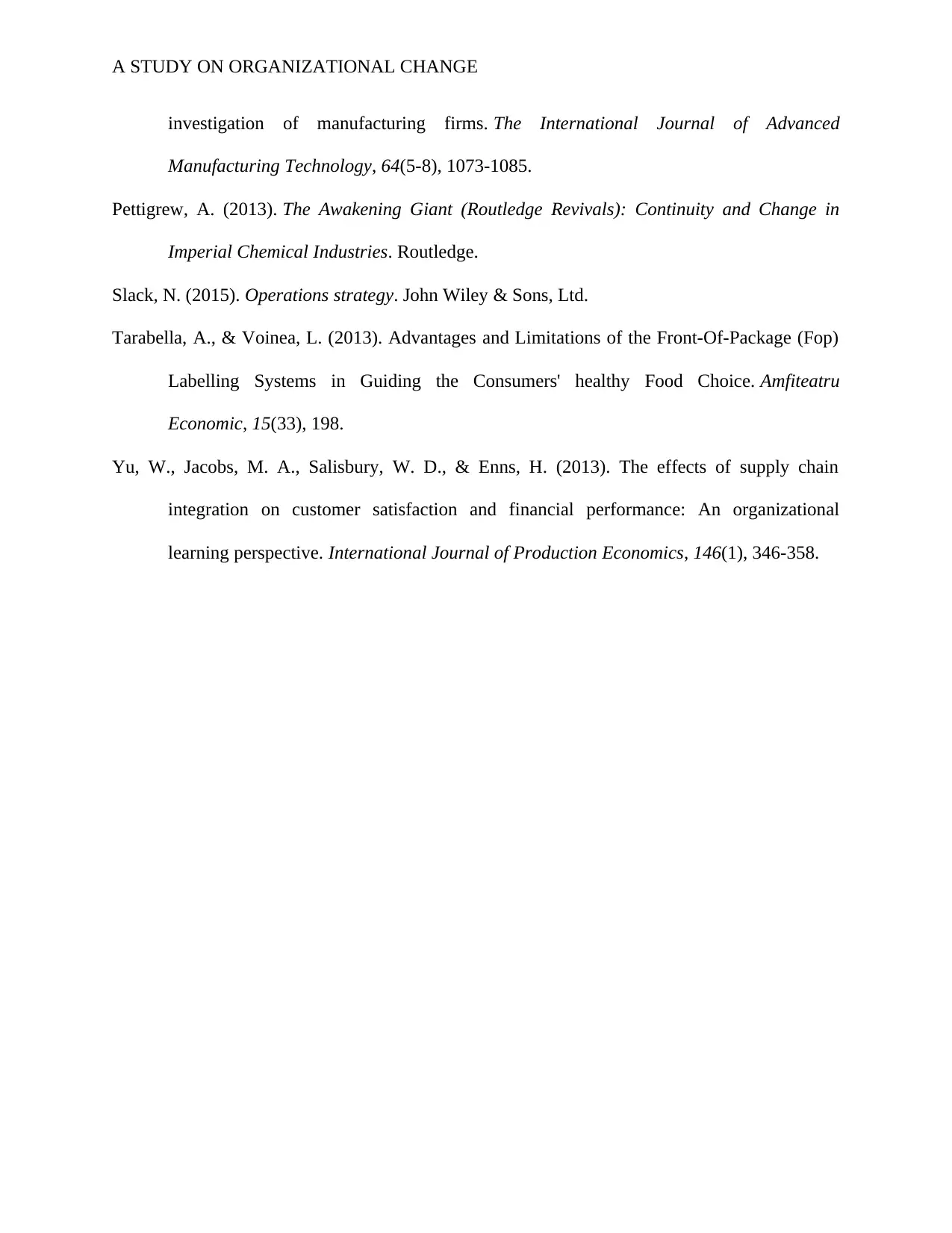
A STUDY ON ORGANIZATIONAL CHANGE
investigation of manufacturing firms. The International Journal of Advanced
Manufacturing Technology, 64(5-8), 1073-1085.
Pettigrew, A. (2013). The Awakening Giant (Routledge Revivals): Continuity and Change in
Imperial Chemical Industries. Routledge.
Slack, N. (2015). Operations strategy. John Wiley & Sons, Ltd.
Tarabella, A., & Voinea, L. (2013). Advantages and Limitations of the Front-Of-Package (Fop)
Labelling Systems in Guiding the Consumers' healthy Food Choice. Amfiteatru
Economic, 15(33), 198.
Yu, W., Jacobs, M. A., Salisbury, W. D., & Enns, H. (2013). The effects of supply chain
integration on customer satisfaction and financial performance: An organizational
learning perspective. International Journal of Production Economics, 146(1), 346-358.
investigation of manufacturing firms. The International Journal of Advanced
Manufacturing Technology, 64(5-8), 1073-1085.
Pettigrew, A. (2013). The Awakening Giant (Routledge Revivals): Continuity and Change in
Imperial Chemical Industries. Routledge.
Slack, N. (2015). Operations strategy. John Wiley & Sons, Ltd.
Tarabella, A., & Voinea, L. (2013). Advantages and Limitations of the Front-Of-Package (Fop)
Labelling Systems in Guiding the Consumers' healthy Food Choice. Amfiteatru
Economic, 15(33), 198.
Yu, W., Jacobs, M. A., Salisbury, W. D., & Enns, H. (2013). The effects of supply chain
integration on customer satisfaction and financial performance: An organizational
learning perspective. International Journal of Production Economics, 146(1), 346-358.
1 out of 11
Related Documents
Your All-in-One AI-Powered Toolkit for Academic Success.
+13062052269
info@desklib.com
Available 24*7 on WhatsApp / Email
![[object Object]](/_next/static/media/star-bottom.7253800d.svg)
Unlock your academic potential
Copyright © 2020–2025 A2Z Services. All Rights Reserved. Developed and managed by ZUCOL.




